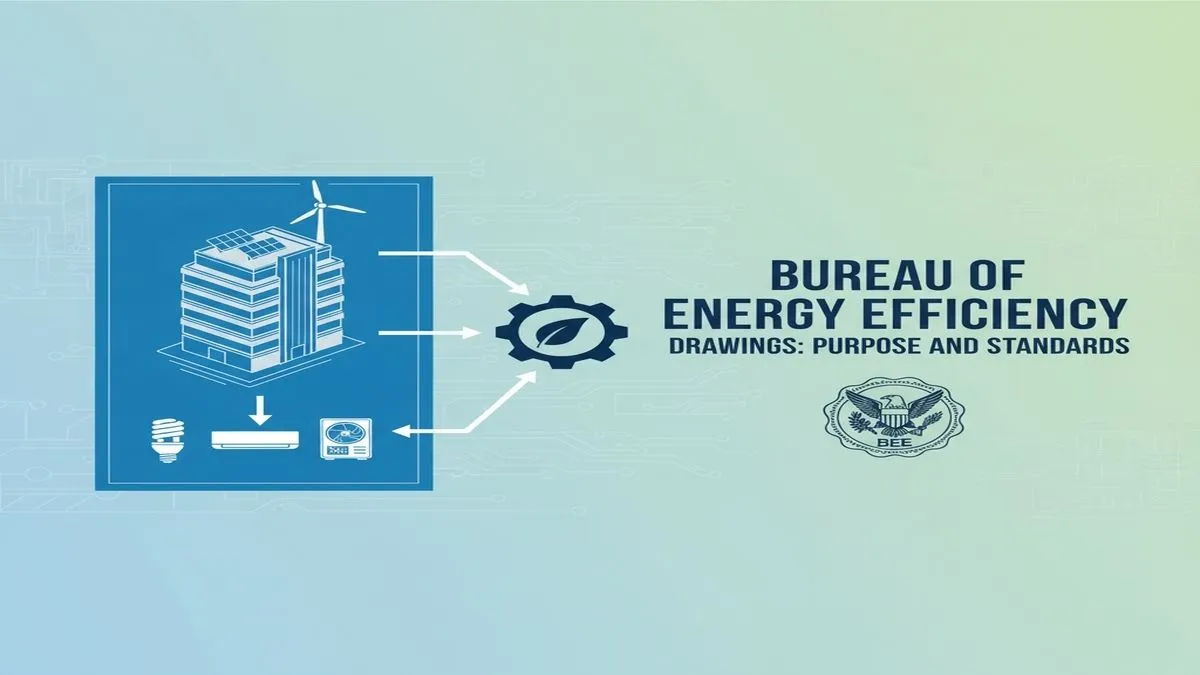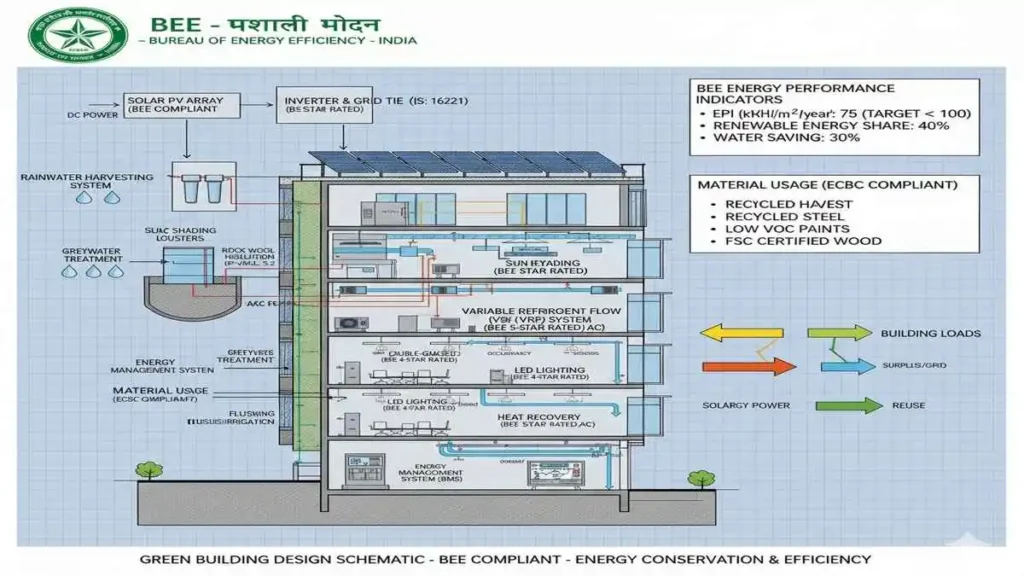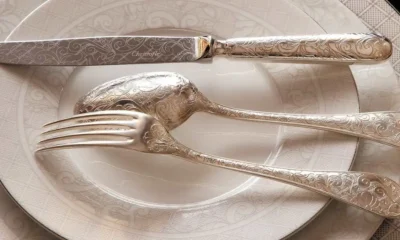GENERAL
Bureau of Energy Efficiency Drawings: Purpose and Standards

A Bureau of Energy Efficiency drawing refers to a technical or schematic illustration prepared according to the standards and regulations established by India’s Bureau of Energy Efficiency (BEE). Operating under the Ministry of Power, the BEE is a government agency that promotes energy conservation, sustainable design, and efficiency across industries. These drawings ensure buildings, products, and industrial systems conform to the prescribed energy efficiency norms.
Table of Contents
What is the Bureau of Energy Efficiency (BEE)?
The Bureau of Energy Efficiency was established in 2002 under the Energy Conservation Act. Its primary mission is to reduce the energy intensity of the Indian economy through regulatory, promotional, and educational measures.
The BEE develops energy standards, certification programs, labelling systems, and building codes to guide manufacturers, architects, engineers, and policymakers toward better energy utilization. By creating measurable benchmarks for efficiency, BEE fosters a market transformation toward more sustainable technologies.
What is a Bureau of Energy Efficiency Drawing?
A Bureau of Energy Efficiency drawing is a technical schematic that visually represents the energy-related aspects of a design, system, or product in line with BEE’s requirements. These drawings often include detailed layouts, electrical schematics, mechanical systems, insulation details, and energy flow diagrams.
In practical terms, these drawings serve as compliance documents demonstrating whether a building or product meets BEE’s established efficiency parameters. They are commonly required for:
- Building projects seeking BEE certification or Energy Conservation Building Code (ECBC) compliance.
- Industrial systems or processes that aim to reduce energy losses.
- Appliances and products that must conform to BEE star labelling standards.
Purpose and Importance of BEE Drawings
1. Ensuring Compliance with Energy Standards
A key objective of the Bureau of Energy Efficiency drawing is to ensure that every project element complies with India’s energy conservation regulations. Engineers and designers use these drawings to validate the incorporation of efficient lighting, HVAC systems, and insulation as the ECBC mandates.
2. Facilitating Energy Audits and Assessments
BEE drawings are reference materials for energy audits to analyze consumption patterns and identify inefficiencies. They provide visual clarity to auditors, helping them pinpoint areas where improvements or retrofits are necessary.
3. Supporting Certification and Approval Processes
To obtain BEE certification or accreditation, developers must present detailed drawings that confirm adherence to BEE’s technical standards. These documents streamline the review process and enable regulatory authorities to evaluate transparently.
4. Enhancing Design Efficiency
Integrating energy efficiency into the early design phase leads to better-performing systems. BEE drawings encourage a holistic approach to sustainability by considering parameters such as natural ventilation, daylighting, and renewable energy integration from the beginning.

Types of Bureau of Energy Efficiency Drawings
1. Architectural Energy Drawings
These drawings focus on building envelope design, insulation, glazing ratios, and passive design strategies. They help assess how architectural choices influence energy consumption.
2. Electrical and Lighting Drawings
Electrical BEE drawings map circuits, lighting fixtures, sensors, and controls that ensure minimum power wastage. They are often designed to comply with energy-efficient lighting standards.
3. Mechanical and HVAC Drawings
For industrial and building systems, HVAC (Heating, Ventilation, and Air Conditioning) drawings detail the energy flow, load distribution, and efficiency of cooling and heating systems.
4. Renewable Integration Schematics
These include solar PV layouts, wind turbine placements, and hybrid systems, reflecting how renewable energy sources are incorporated into the overall energy plan.
Components of a BEE Drawing
A well-prepared Bureau of Energy Efficiency drawing typically includes:
- Title Block: Project name, drawing title, date, and reference to BEE standards used.
- Legends and Symbols: Standardized icons for electrical, mechanical, and energy components.
- Load Calculations: Details of power loads, lighting levels, and HVAC capacities.
- Energy Modelling Data: Inputs from simulation software like eQUEST or DesignBuilder.
- BEE Star Rating or ECBC Reference: This clearly indicates the expected energy performance benchmark.
Relevance in Building and Industrial Sectors
1. Building Sector
In modern construction, BEE drawings are integral to green building certifications such as GRIHA and LEED India. They comply with ECBC 2017 or later updates, emphasizing envelope optimization, efficient lighting, and renewable integration.
2. Industrial Sector
In manufacturing, cement, and steel industries, BEE drawings guide the implementation of energy-efficient process systems. They help engineers visualize how energy flows through the system and where losses can be minimized.
3. Product Design
Appliance manufacturers use BEE standards to design and label products under the BEE Star Rating Program. The associated drawings help confirm compliance before products reach the market.
Tools and Standards Used in BEE Drawings
Professionals typically employ computer-aided design (CAD) and Building Information Modelling (BIM) software to produce precise and scalable BEE-compliant drawings. Commonly referenced standards include:
- Energy Conservation Building Code (ECBC)
- National Building Code (NBC) energy provisions
- BEE Star Rating Guidelines for appliances
- ASHRAE and ISO standards for comparative analysis
These frameworks ensure that BEE drawings align with national and international energy-efficient design best practices.
Challenges in Preparing BEE Drawings
While essential, developing BEE-compliant drawings poses several challenges:
- Complex Regulatory Frameworks: Staying updated with evolving BEE standards requires continuous professional training.
- Data Integration: Accurate modelling demands reliable climatic and operational data.
- Coordination Among Disciplines: Architectural, electrical, and mechanical teams must collaborate closely to ensure consistency.
- Verification and Approval Delays: The review process for certification can be time-consuming if documentation is incomplete.
FAQs
1. What software is commonly used to create Bureau of Energy Efficiency drawings?
AutoCAD, Revit, and other BIM tools are typically used to prepare precise BEE-compliant technical drawings.
2. Who is authorized to approve a Bureau of Energy Efficiency drawing?
Only certified energy auditors, accredited professionals, or BEE-approved agencies can review and approve such drawings.
3. Do Bureau of Energy Efficiency drawings differ by project type
The content and standards vary depending on whether the project involves buildings, industrial systems, or consumer products.
Conclusion
A Bureau of Energy Efficiency drawing is far more than a technical representation; it is a cornerstone of sustainable design and energy governance in India. By adhering to BEE’s standards, such drawings ensure that every building, industrial plant, and product design contributes to the nation’s energy conservation and environmental protection efforts.
Through precision, compliance, and innovation, BEE drawings embody the country’s ongoing commitment to a more efficient, responsible, and sustainable energy future.
-

 GENERAL6 months ago
GENERAL6 months agoChristofle – For Those Who Dream of Family Heirloom Silver
-

 SPORTS8 months ago
SPORTS8 months agoDiscover the World of Football with Streameast: Watch Your Favorite Leagues and Tournaments
-

 GENERAL4 months ago
GENERAL4 months agoUncovering the World of кинокрадко: The Dark Side of Film Piracy
-

 GENERAL2 months ago
GENERAL2 months agoATFBooru: Anime, Gaming, and Subculture Imageboard























